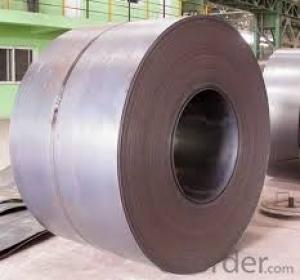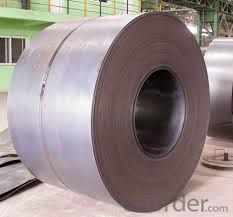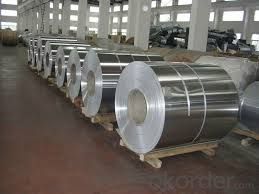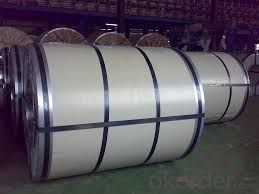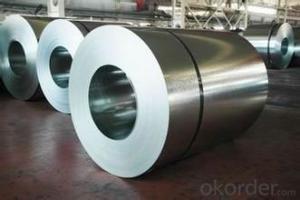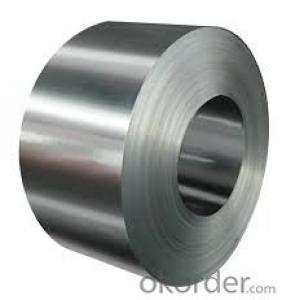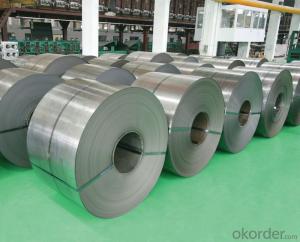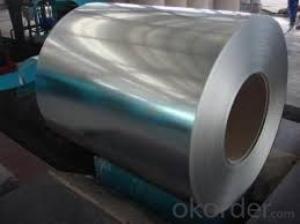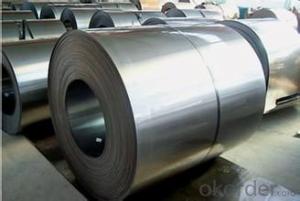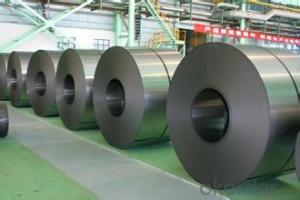Cold Steel Rolled different size/Cold Rolled Steel/
- Loading Port:
- Shanghai
- Payment Terms:
- TT OR LC
- Min Order Qty:
- 20 m.t.
- Supply Capability:
- 10000 m.t./month
OKorder Service Pledge
OKorder Financial Service
You Might Also Like
Product Description
The detail specification of cold rolled stainless steel coils are as below:
| Grade: | 201/202/301/304/304L/316/316L/317L/321/409/409L/410/410S/430/439 |
| Standard: | ASTM,AISI,JIS,EN,DIN,GB |
| Surface: | 2D,2E,2B,2BB,SB,NO.4,BA,HL,6K,7K,8K |
| Width: | 1000mm/1219mm/1250mm/1500mm/1524mm/1829mm/2000mm |
| Thickness: | 0.3mm to 6mm |
| Edge: | Slit/Mill Edge |
| Origin: | TISCO,POSCO,LISCO,JISCO,BAOSTEEL,Baoxin,Eastern Special Steel and so on |
| Productivity: | 5000MT/Mont |
| MOQ: | according to buyer's order |
| Payment Term: | TT,L/C at sight/, L/C 30,60,90,180 days,WEST UNION |
| Price Term: | FOB/CFR/CIF Ningbo,Shanghai,Tianjin,Shenzhen Port |
| Delivery: | 7-10 days after receive buyer's advance deposit or LC copy |
| Packaging: | Seaworthy Export Standard Package.Products are packed and labeled according to the regulations and customer's requests. Great care is taken to avoid any damage which might otherwise be caused during storage or transportation. In addition, clear labels are tagged on the outside of the packages for easy identification of the product I. D. and quality information. |
| Detail Application: | construction field;ship building industry;petroleum and chemical industries;war and electricity industries;food processing and medical industry; boiler heat exchanger; machinery and hardware industry |
Technical notes:
| Surface Finish | Definition | Application |
| NO.1 | The surface finished by heat treatment and pickling or processes corresponding there to after hot rolling. | Chemical tank, pipe. |
| 2D | Those finished, after cold rolling, by heat treatment, pickling or other equivalent treatment. | Construction Material, heat exchanger,exhaust pipe |
| 2B | Those finished, after cold rolling, by heat treatment, pickling or other equivalent treatment and lastly by cold rolling to given appropriate luster. | Medical equipment, Food industry, Construction material, Kitchen utensils. |
| BA | Those processed with bright heat treatment after cold rolling. | Kitchen utensils, Electric equipment, Building construction. |
| NO.3 | Those finished by polishing with No.100 to No.120 abrasives specified in JIS R6001. | Kitchen utensils, Building construction. |
| NO.4 | Those finished by polishing with No.150 to No.180 abrasives specified in JIS R6001. | Kitchen utensils, Building construction, Medical equipment. |
| HL | Those finished polishing so as to give continuous polishing streaks by using abrasive of suitable grain size. | Building Construction. |
| No.8 | A highly reflective finish obtained by polishing with successively finer abrasive and buffing extensively free of grit lines | Indoor decoration & Reflector, Hospital Equipment |
Our Advantages
All products are made of high-quality imported raw materials.
Excellent shipment after-sales service & Prompt
The Authorized agent of TISCO,JIISCO,the stainless steel distributor of BOSTEEL,ZPSS,LISCO and also can get the resources from all the stainless steel mills in China.
Have own processing and distribution center & can take the orders according to customers' requirements.
The transport in Hangzhou is very convenient & nearby Shanghai and Ningbo Port.
Our products are certified by ISO9001:2008 authentication quality systems.
We are held by Zhejiang Materials Group,which is one of the world Top 500 Enterprise
Quick Response to Your Enquiry
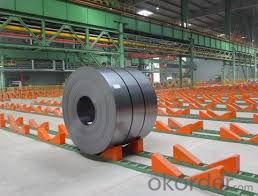
- Q: How are steel coils used in the production of packaging machinery?
- Steel coils are used in the production of packaging machinery as they serve as the raw material for manufacturing various components of the machinery, such as frames, supports, and structural elements. The steel coils are processed through cutting, bending, and welding to create the necessary parts, ensuring durability and stability in the packaging machinery's construction.
- Q: What is the standard length of steel coils?
- The standard length of steel coils can vary depending on the specific industry and application. However, a common standard length for steel coils is typically around 30 feet or 9.1 meters.
- Q: How are steel coils heat treated?
- Steel coils are heat treated using a process called annealing. Annealing is a heat treatment technique in which the steel coils are heated to a specific temperature and then slowly cooled down. This process helps to relieve any internal stresses within the steel, improve its mechanical properties, and enhance its overall performance. The heating process involves raising the temperature of the steel coils to a critical point, typically between 800°C and 900°C, depending on the specific grade and desired outcome. The coils are then held at this temperature for a specific period of time, allowing for the transformation of the steel's microstructure. Once the desired time has elapsed, the heated steel coils are slowly cooled down in a controlled manner. This slow cooling process is vital as it allows the steel to undergo a gradual transformation, resulting in a more uniform and refined microstructure. This controlled cooling also helps to minimize the formation of internal stresses, which can potentially weaken the steel. The annealing process can be performed in different atmospheres, such as air, nitrogen, or hydrogen. The choice of atmosphere depends on the specific requirements and properties desired for the steel coils. For instance, annealing in a protective atmosphere like nitrogen or hydrogen can help prevent oxidation or decarburization of the steel surface. Overall, heat treating steel coils through annealing is a critical step in enhancing their mechanical properties, improving their formability, and achieving the desired characteristics for various industrial applications.
- Q: Who started or popularized the use of the steel guitar in country music? Early country songs contained no steel guitars but by 1950 the steel guitar had become a staple of country music.
- You're an idiot. Only an ignorant fool would attempt to generalize an entire genre into one unappealing stereotype, rather than putting forth the effort to actually LISTEN to the music. 'Horrible Instrumentals?' Really? Some of the best guitar players on the planet are country singers (ever heard of Brad Paisley? Keith Urban? Chet ADKINS, for gods sake, who, in his prime, was one of the best guitarists on the planet?) 'Terrible Vocals'? You're joking, right? I know you're joking. You HAVE to be joking, considering the amount of 'talent' most popular pop artists at the moment have. Ever heard Katy Perry sing Live? Rihanna? Britney Spears? Miley Cyrus? Fergie? Selena Gomez? Ke$ha? And these are the most dominant pop singers in the world right now. And you think its your place to be criticizing country musician's vocals? Country music is KNOWN for having phenomenally talented singers, both in and out of the studio. (Carrie Underwood, Brad Paisley, Faith Hill, Tim McGraw, Toby Keith, Lady Antebellum, Reba McEntire, Rascall Flatts and many, many more) Mediocre Topics? Love, Heartbreak, Family, Patriotism, Sex (occasionally). The same general topics that EVERY genre explores. How would you like it if i said that all rappers sing about is f*cking b*tches and driving fancy cars? Yeah, I'm guessing you'd think that sounded pretty ignorant. Dull Lyrics? Country music is known for being the kind of music that tells a story throughout the song, not just repeating the same few catchy verses and a chorus like other genres. If you find that kind of story telling boring, then go listen to some Katy Perry. She sounds like she's more your style.
- Q: Can steel coils be stored in a corrosive environment?
- No, steel coils should not be stored in a corrosive environment as it can lead to the degradation of the steel surface and compromise its structural integrity.
- Q: Hi all.I'm working on a project which requires about 3 steel pipes at 25mm in diametre and about a foot each in length.The qualities I need with the steel is that:1. I need it to be easy enough to weld together2. I need to be able to drill holes through them with a basic drill (I could buy different bits, that's fine)3. I need the steel to be able to take short intense repeated bursts of strain through said holes4. The lighter the steel the better5. Could I please have a ballpark figure for price. I can't imagine such a small amount of steel would cost too muchThank you in advance for your replyRegardsSean
- I do not understand what is meant by, ...repeated bursts of strain through said holes, but I would think that standard a pipe for home plumbing would do. In my vicinity, and I practice own home plumbing, I buy a whole pipe 6 meters long for about the equivalent of $(20-15). A local plumber might give you the short pieces you after for free.
- Q: How are steel coils stored in warehouses?
- Steel coils are typically stored in warehouses by stacking them securely on top of each other, either directly on the warehouse floor or on specially designed racks. They are often stored vertically to save space and ensure stability. Additionally, to prevent damage and corrosion, steel coils are often wrapped in protective materials or placed on pallets.
- Q: Hi there! I just purchased two cookie sheets labeled as non-stick 100% carbon steel. I've never heard of carbon steel before, and I'm trying to be careful about not using certain products that are harmful to health such as aluminum and Teflon. Is this a safe metal choice for baking?
- This Site Might Help You. RE: Is 100% carbon steel baking sheet safe? Hi there! I just purchased two cookie sheets labeled as non-stick 100% carbon steel. I've never heard of carbon steel before, and I'm trying to be careful about not using certain products that are harmful to health such as aluminum and Teflon. Is this a safe metal choice for...
- Q: How are steel coils used in the manufacturing of shipbuilding?
- Steel coils are used in shipbuilding for several purposes. They are primarily used to fabricate the hull and structural components of ships. Steel coils are cut, shaped, and welded to form various ship sections, such as the hull plates, bulkheads, and decks. These coils provide the necessary strength, durability, and corrosion resistance required for marine applications. Additionally, steel coils are also used to manufacture other shipbuilding components like piping, machinery, and equipment, ensuring the overall integrity and functionality of the vessel.
- Q: I was wondering if steel cases can be loaded to the same pressure as brass cases. Are the cartridges that commonly feature steel cases like the Russian 5.45x39, 7.62x39 and 7.62x54R loaded to a lower pressure than their C.I.P. MAPs (380 MPa, 355 MPa, 390 MPa --gt; 51,488 psi to 56,564 psi)? There must be a reason why most NATO armies use brass cases...
- The ammo loaded in steel casing has a tendency to be loaded at lower pressures, for some reason. Most if not all of the steel case is of foreign manufacture. No reason steel can't be loaded to same pressures to that of brass, would probably seal better. Most of the calibers you describe in steel cases go in weapons with loose tolerances, like the AK. Lot of times, the steel won't seal in the chamber, creating blow by, putting crud in the chamber. This condition makes it hard to feed, chamber, and extract in a tight dimension chamber that is present in NATO weapons. AK's, due to more generous tolerances, won't be sensitive to this.. Weapons from NATO are of more tightly toleranced chambers like the AR, HK, Barret, etc. where brass is more reliable in sealing, and minimizes the blow by and keeps things clean, or at least more clean than a steel case that may not seal.
Send your message to us
Cold Steel Rolled different size/Cold Rolled Steel/
- Loading Port:
- Shanghai
- Payment Terms:
- TT OR LC
- Min Order Qty:
- 20 m.t.
- Supply Capability:
- 10000 m.t./month
OKorder Service Pledge
OKorder Financial Service
Similar products
Hot products
Hot Searches
Related keywords
